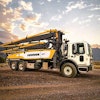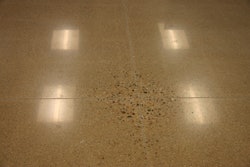
It’s also referred to as shrinkage cracking and plastic shrinkage. But whatever you choose to call it surface cracking and surface crusting are due to ambient conditions surrounding freshly placed concrete until it gets hard. It results when the surface either loses more moisture than can be replaced by bleed water in the concrete or when the surface layer of a slab gets hard before the concrete below. The damage this causes can be cracking all over the top of a slab, the loss of surface flatness, loss of strength in the top regions, or in the case of stamped concrete the unsightly destruction of the surface. Solving these problems starts with recognizing the conditions that cause it before it occurs and taking appropriate action.
The ACI 116 committee defines surface cracking as “cracking that occurs in the surface of fresh concrete soon after it is placed and while it is still plastic.” In its most severe form, surface crusting, a brittle crust forms that can be as thick as half an inch. There isn’t much that can be done once a crust like this forms.
Conditions that cause surface shrinkage and crusting
There are several ambient conditions working together that contribute to cracking on the surface of fresh concrete: air temperature, wind speed, relative humidity, and direct sunlight. Surface crusting is a phenomenon involving excessive temperature differentials between freshly placed concrete and the temperature of the surface being heated by the sun. The temperature of the ground can have a contributing effect if it causes ready-mix temperatures to drop. Concrete mix ingredients such as the amount of cement, supplementary cementitious materials (SEM), and admixtures such as retarding agents also play a roll.
The Nomograph
Luke Snell, a concrete consultant in Edwardsville, Illinois says the origins of a nomograph that could predict whether fresh concrete was at risk of surface crack formation goes back to a formula worked out in Europe in 1802. It was originally devised to determine water lost to evaporation on lakes. The complicated formula was refined and used in the U.S. in the 1950s to evaluate the construction of Lake Hefner, Oklahoma, located in a relatively dry area. Engineers wanted to know if evaporation caused by local conditions could accurately be predicted. The data from this project was used to further refine the evaporation equations. Then in July of 1960 Delmar Bloem published in a paper for the National Ready Mixed Concrete Association and National Sand and Gravel Association. The nomograph he developed was based on a more complicated table developed by Carl Menzel in 1954. Today it can interpret the amount of evaporation taking place on surfaces under different weather conditions. The surface material didn’t matter; it can be the surface of a lake, dirt, wood, fresh concrete, and even hardened concrete—any surface water vapor can pass through.
Contractors today are accustomed to getting weather information on their smart phone in order to make decisions about whether to place concrete that day. But this information might come from an airport or some other information gathering site located 30 miles away from the jobsite where weather conditions could be very different. To predict whether conditions are good for successfully placing concrete the nomograph requires ambient weather information taken at the jobsite. ACI 308 states that the information should be collected 20 inches above the placement and 2 feet away from an edge form, whether the placement is on the ground or 100 feet above ground.
If the nomograph reports a score of 0.2 pounds/square foot/hour or more it means that plastic shrinkage is likely to occur because most concrete mixes can’t replace water lost from the surface with bleed water from below quickly enough. Mixes containing pozzolans and dense well-graded mixes have even slower bleed rates and are more susceptible to cracking.
Readings below 0.1 mean plastic cracking is unlikely.
Kestrel
Snell says he approached the Kestrel Corporation located in Boothwyn, Pennsylvania, because they manufactured a quality small, lightweight, accurate weather instrument that collected all the needed data for the nomograph formula. In 2007 they agreed to develop an instrument (their 4300 weather meter) to serve the concrete industry, including the nomograph formulas to report pounds/square feet/hour evaporation rates. Chris Vugrincic, in charge of Business Development and Industrial Instruments, says they improved the instrument in 2015 with the introduction of the 5300 model. “It runs the same nomograph equation, has Bluetooth, links with smart phones to show the results which can be emailed to others, it logs data, and it shows air flow volume calculations used by contractors. It can download this data to a computer with the help of a Dongle or a USB cable.
Austin Wilcox, the companies Senior Product Manager, says they also sell a “Concrete Pro Jobsite Weather Monitoring Kit” that includes a tripod to mount the weather instrument 20-inches above the concrete surface. The kit also includes a weather vane to automatically keep the instrument directly facing the wind.
IR Thermometers
The nomograph formula also requires ready-mix temperatures—concrete coming out of the truck and on the ground as time proceeds. Infra-red (IR) thermometers are a good way to collect this information. They also make it easy to measure ground temperature and concrete surface temperatures.
IR thermometers are small and light. They work by measuring the infrared radiation that all objects emit; the hotter an object the more IR energy is emitted. But materials radiate energy at different rates and the rate for each material is referred to as its emissivity. The emissivity for concrete is approximately 0.95 and that is the same as many other construction materials.
IR thermometers report the temperature of the surface of a material instantly and instruments can be purchased with programmable emissivity or preprogramed 0.95 emissivity only, the latter being the least expensive.
What if...?
Using the formulas in the nomograph Snell put together a spread sheet to see what happens to the surface evaporation rates when any of the ambient conditions are changed, or if ready-mix temperatures are changed. You can go to. https://acimissouri.starchapter.com/downloads/Calculators/curing__english_units.htm. Snell says you can also email him at [email protected] and he will send you a direct link to his spread sheet.
First you enter the jobsite weather conditions and ready-mix temperature and the spreadsheet calculates the surface evaporation rate. If it is less than 0.1 pounds/square feet/hour conditions are safe and the answer is reported in green. If the results are between 0.1 and 0.2 the results are marginal and are reported in yellow. But if the answer is greater than 0.2 conditions shrinkage cracking will occur and the results are reported in red.
Once you have calculated the surface evaporation rate for your project you can use Snell’s spread sheet to play “what if” by changing each of the weather variables or the concrete temperature to figure out what has to happen in order to place concrete safely.
Surface crusting
The temperature of the ground, concrete, and the surface of freshly placed concrete can cause unfavorable conditions too, especially if the concrete is colored a dark color and there is strong sunlight heating the surface. The initial set of concrete is largely a function of heat, for every 18°F rise in concrete temperature the initial set time doubles. Sunlight can heat the surface well above 140°F causing it to get hard well ahead of the concrete below the surface. Placing dust-on color hardeners which have higher levels of portland cement than the concrete below can make the problem even more worse. When this condition occurs trying to stamp decorative patterns or finish the surface with troweling machines results in massive cracking and distorted surfaces.
There is little that can be done when temperature differentials between the surface of a freshly placed slab differs significantly from the concrete below. The best approach is to recognize the potential problem before concrete is placed. If you measure a significant temperature differential you might decide that it’s best not to place concrete that day, add an accelerating admixture to the concrete to encourage “bottom set” to occur before “top set” does, or find a way to protect your work from sunlight or other heat source.
Curing issues
Surface cracking can occur due to inadequate curing conditions—when there isn’t enough moisture to fully cure the surface of the slab. So Vugrincic says his company invented the “Drop” to help monitor ambient conditions during the curing cycle. Like their weather instrument, the Drop should be mounted 20 inches above the work and two feet away from a formed edge. It records temperature and relative humidity and transmits the information via Bluetooth to a smart phone. You can also use your phone to set Drop intervals between readings. Knowing what the ambient conditions are on the surface of the slab can help you decide if additional curing steps are necessary and it provides you with accurate job history information and protection in the event that legal issues arise.
Surface crusting and cracking
These problems can be prevented by knowing what the conditions are before placing concrete. Once known you have to decide whether it’s wise to place concrete and if you elect to proceed than what precautions to take.



















